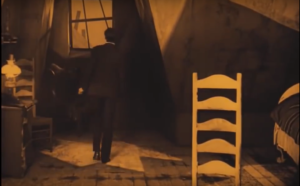The Cabinet of Dr Caligari (1920, dir. Robert Weine) was created in Germany by a film studio known as Decla. It is a well-known silent horror film that influences many other films, including some in modern day cinema as well as film noir in the 1950’s-60’s.

In this scene, you are able to see where these strips of light have been painted on the floor. It was made in the period of German Expressionism which allows this to show the genre of the film. One feature that is shown is the Distorted Landscapes, which is prominent in this shot. The set appears disoriented due to the slanted window which, again, accentuates the context of German Expressionism, however this could be viewed as a foreshadowing of the fact that this story was told by a mental patient with a disoriented mind. This warped appearance allows the audience to see things through the mind of the mental patient. This twist ending was what made The Cabinet of Dr Caligari a cinematic breakthrough, due to the unreliable narrator and the plot-twist.
In this film, an “Iris Wipe” is frequently used which is an editing effect that typically closes the iris of a camera and then slides a piece of card over it to make the shot cut to black. This technique was used in the shot where Francis tells the story about the fair. In this flashback scene, the iris cut shows the audience that it is a flashback scene and creates a surreal like feeling to the scene to make sure that the audience is aware that it’s a memory. This film had no outside shots and was produced entirely on made up sets which means that they used artificial lighting. This led to them painting strips onto the sets of light and dark in order to present shadows and contrast.
The characters’ emotions had to be cleverly expressed, due to the fact they couldn’t talk, and also highly detailed. Weine found a way to show how each character was feeling, in this film, by the use of makeup. When Cesare is first exposed to the audience, his dramatic makeup is emphasised in the close-up where he is first revealed. The dark eyes and lips establish him as the villain, and create a creepy feel to the audience. The Mise-en-scene in this film was used as expression in order to create emotions that can’t be presented through speech to the audience.
